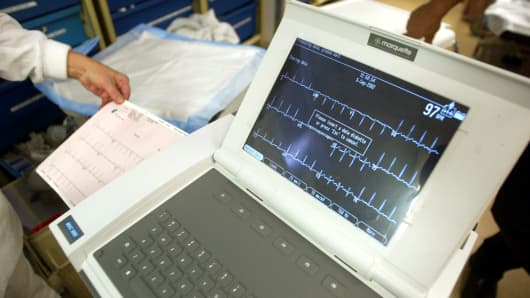Two hedge fund “quants” have come up with an algorithm that diagnoses heart disease from MRI images, beating nearly 1,000 other teams in one of the most ambitious competitions in artificial intelligence.
Tencia Lee, who recently left Los Angeles-based Crabel Capital Management to join a robotics start-up, said she and partner Qi Liu, a former employee of hedge fund Two Sigma, had not previously worked before with the winning technology, called deep learning.
Ms Lee and Mr Qi entered the contest in December and created a method that has proved, in early tests, to be as effective as a cardiologist in analysing images of the heart.
“People have been working on this for 15 years — I’m amazed what kind of results came out of this competition in three months,” said Andrew Arai, chief of advanced cardiovascular imaging at the National Institutes of Health.
MRIs are used to diagnose heart disease around 1m times a year in the US, Mr Arai said, with cardiologists spending an average of 20 minutes on each image. That could make the algorithm an important addition to a growing field of automated medical imaging, though it faces stringent formal tests before it can be adopted.
More from The Financial Times:
Robotics: Stretchable skin adds colour to machines
Scientists create the simplest form of life yet known
Native English speakers must learn how they come across
The winning entry used a so-called convolutional neural network, a form of deep learning designed to emulate the way vision works in animals.
Ms Lee said that neither of the pair had worked with neural networks before and had taken software from GitHub, an online repository of open-source software, to solve the challenge. The main problem they faced had been to define the problem in a precise enough way, she added. After that, it was a question of feeding examples of heart MRIs into the neural network and letting it work out the solution.
The availability of such software meant that even complex problems were open to being solved by experts with a more general background in data science, Ms Lee said. “We are both very experienced with working with large amounts of data, and having an intuition about where to look for problems,” she said. “It took all my spare time over a period of three months.”
Recent technology advances are “allowing us to do things with images that were not possible three or four years ago”, said Anthony Goldbloom, chief executive of Kaggle, which ran the National Science Data Bowl competition with consultancy Booz Allen Hamilton.
The changes include development of specialised chips suited to pattern recognition, called graphical processing units, or GPUs, and big increases in computing capacity, he added.
Open competitions have become an increasingly common way to solve difficult data science problems. Netflix ran one of the most prominent in 2009 with a $1m competition to come up with an algorithm to make film recommendations.
Kaggle, which conducts about 50 competitions a year on behalf of big companies, said the heart imaging challenge was the hardest it had run. The chance of winning instant fame in their field, even more than the prize money, accounted for the large number of people who entered such contests, Mr Goldbloom said.
Sander Dieleman, a PhD student in neural networks who headed a team from the University of Ghent that won last year’s National Data Science Bowl, has since been hired by DeepMind, Google’s UK-based deep-learning arm whose system recently beat the top human champion at the board game Go.
Ms Lee and Mr Qi entered the competition individually and were placed in the top 10 after an early round. They teamed up after Mr Qi posted a message on Kaggle seeking help.
Follow CNBC International on Twitter and
[“source -cncb”]


